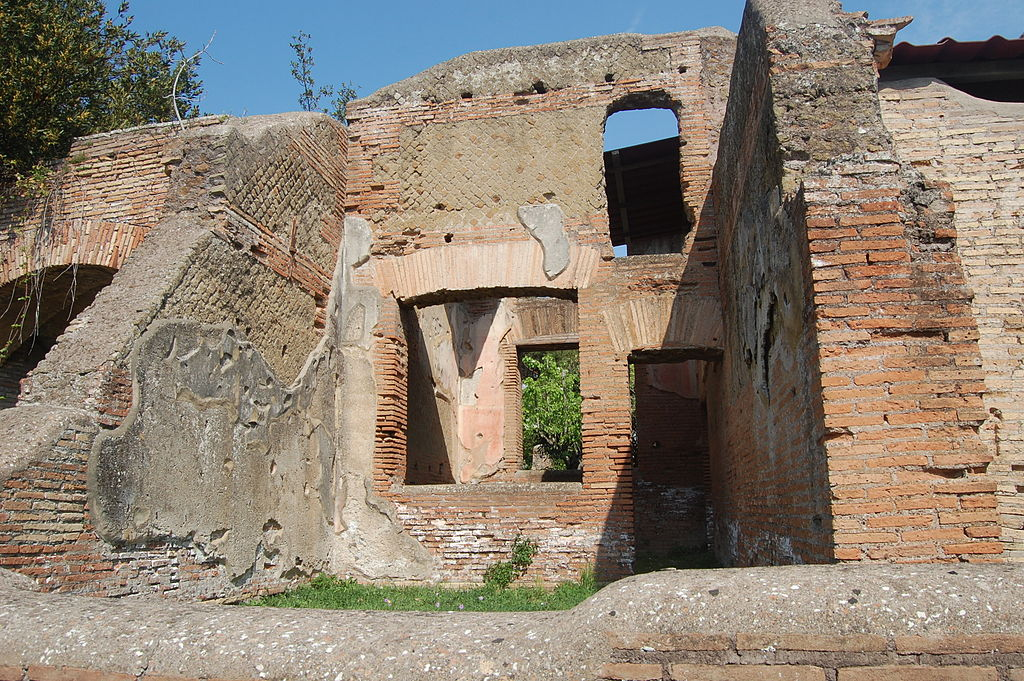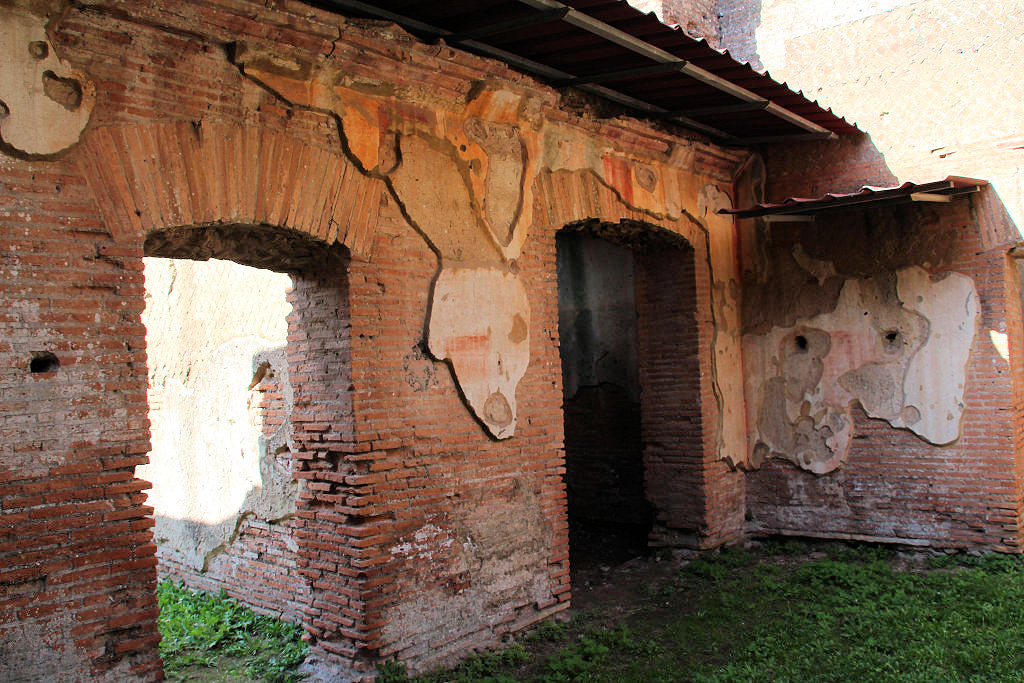The House of the Paintings is one of two Hadrianic medianum apartments to the west of the large garden in the Insula of the Paintings (128-138 AD). It was excavated in 1878 by Rodolfo Lanciani. It was the first apartment to be discovered in Ostia and received its name because at the time the extensive remains of paintings were a novelty. Lanciani thought that it was originally a warehouse, later changed to an apartment. Later research showed that it was an apartment from the start. After the excavation the paintings deteriorated rapidly. They were described in 1910 by Jérôme Carcopino, in 1912 by Ludovico Paschetto, and in 1913 by Francesco Fornari.
Plan of the houses in the block, Hadrianic phase.
Ground floor (top) and first floor (bottom).
North is to the left. DeLaine 1995, fig. 5,2.The apartment received light and was accessible from the garden and from Via dei Dipinti to the west. The road was never paved with basalt blocks. The medianum (6) is flanked by the representative rooms 3 and 10, that have high ceilings. An internal staircase in room 9 led to the first floor. Other, independent apartments on the upper floors were reached via stairwell 1. The floors of the ground floor were decorated with geometric black-and-white mosaics. In the later second century some modifications took place in rooms 5 and 7. In the Severan period the two doors leading from the garden to the medianum and the external staircase were blocked.
The paintings were described by Carcopino as follows. On the south wall of room 2 were broad yellow bands on a white background. On the north wall red bands alternated with yellow bands. On the east wall, above the window, were pieces of painted decoration: on the left architectural drawings in red and yellow, on the right, in a register where green dominates, a little landscape (0.25 cm. x 0.07 cm). This landscape consisted of a reddish boat on a river crossed by a bridge and with porticoes along the banks. In room 3, on the red background of the east wall and between architectural lines, were running figures and a woman whose head is adorned with a diadem surmounted by a crest (Isis?). On the south wall, above the door, was a flying figure, in green, holding a red cloth in his left hand, standing out against a yellow background. The paintings in medianum 6 had almost completely disappeared. Those of room 5 were better preserved. On the north wall was a mixture of red, white, grey and grey-green. On the south wall, on a yellow background, were a landscape and flowers. The best-preserved paintings were those of main room 10. On the west wall, to the left, was a man with long hair, in red, standing out against a yellow background. On the south wall, below a figure in a white toga and a flying goddess, was a scene measuring 0.80 x 0.75 cm. Against a blue background three figures seemed visible: on the right, a seated figure turned to the left; then, turned to the right, a smaller figure; on the far left, a woman whose purple dress leaves her arm exposed. She is walking and lets herself be guided by the second figure towards the first. She stretches out her right hand towards him and he holds out his. This was perhaps Juno whom Cupid leads to Jupiter.
Paschetto describes the south wall of main room 10. He mentions red and yellow panels, with in the centre a naked male figure standing on a truncated pyramid. Above him is a male statue standing on a pedestal, below him a scene of three persons, of which only the leftmost can be distinguished clearly: a woman with a purple and green dress. To the left, still on the same wall, are three more panels. In the top panel is a male figure wearing a white tunic on a red background. Below him is a walking woman wearing a fluttering green dress, and below her a woman wearing a purple dress. On the west wall are red bands on a yellow background. On the lower left corner a male head with large eyes can be distinguished. In the north-west corner of medianum 6 are red bands on a yellow background, and the depiction of a door with a porticus, next to which is a woman with a fluttering blue dress, the right arm stretched out, the curved left arm holding a lance or sceptre. Room 5 to the west has red and white lines on a yellow background, and depictions of flowers and birds. In room 2 are red and yellow bands on a white background. On the east wall is a small panel with green paint and perhaps here can be seen what Carcopino described: a boat on a river with a bridge and porticos on the banks. In room 3 white figures are painted on panels with a red background, including a floating woman, a walking naked man, and a woman with a green and red dress.
Fornari's description is cursory. On the south wall of main room 10 he distinguishes three horizontal zones. The lower zone imitated marble slabs and contained small panels with figures. The central panel on the lower zone contained three figures, below a man standing like a statue on a truncated pyramid. The middle zone seemed to depict windows, showing architecture in the background. The upper zone again contained small panels with figures. Fornari notes oblique lines and asymmetry. In an unspecified room (probably room 3) he describes large red and yellow frames around red-brown panels, on one of which is a figure that seems to fly. In yet another room (probably medianum 6) he describes architectural elements, including columns, and a small yellow panel with oblique red and white lines. Finally he seems to mention room 2. Here he describes a slender construction with an oblique cornice, and a small rectangular panel with a landscape.
Plan of the houses in the block, Severan period.
Ground floor (top) and first floor (bottom).
North is to the left. DeLaine 1995, fig. 5,4.








